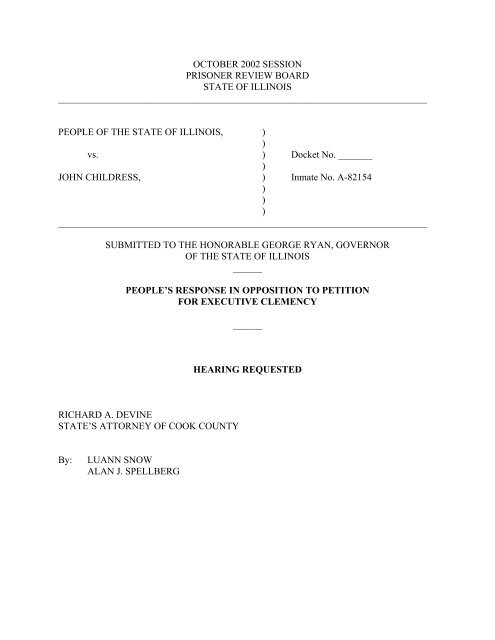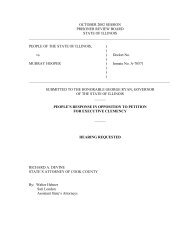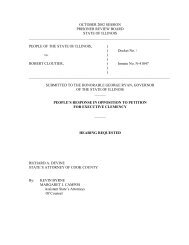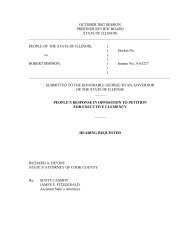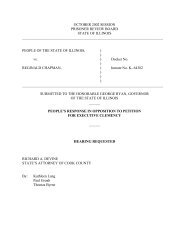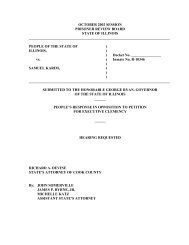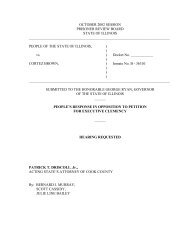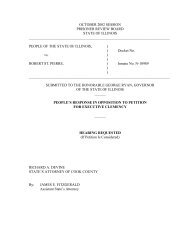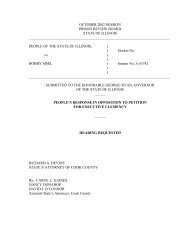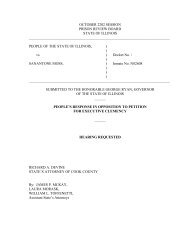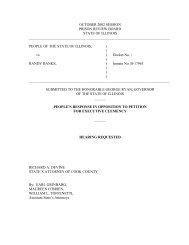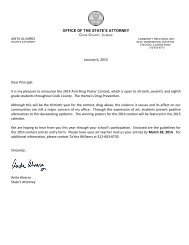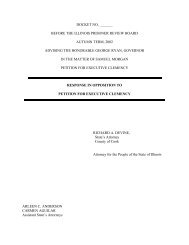John Childress - Cook County State's Attorney
John Childress - Cook County State's Attorney
John Childress - Cook County State's Attorney
You also want an ePaper? Increase the reach of your titles
YUMPU automatically turns print PDFs into web optimized ePapers that Google loves.
OCTOBER 2002 SESSIONPRISONER REVIEW BOARDSTATE OF ILLINOIS____________________________________________________________________________PEOPLE OF THE STATE OF ILLINOIS, )vs.)) Docket No. _______JOHN CHILDRESS,)) Inmate No. A-82154)))____________________________________________________________________________SUBMITTED TO THE HONORABLE GEORGE RYAN, GOVERNOROF THE STATE OF ILLINOIS______PEOPLE’S RESPONSE IN OPPOSITION TO PETITIONFOR EXECUTIVE CLEMENCY______HEARING REQUESTEDRICHARD A. DEVINESTATE’S ATTORNEY OF COOK COUNTYBy:LUANN SNOWALAN J. SPELLBERG
OCTOBER 2002 SESSIONPRISONER REVIEW BOARDSTATE OF ILLINOIS____________________________________________________________________________PEOPLE OF THE STATE OF ILLINOIS,vs.JOHN CHILDRESS,))) Docket No. _____)) Inmate No. A-82154)))____________________________________________________________________________IFACTS OF THE CASEOn August 15, 1989, petitioner <strong>John</strong> <strong>Childress</strong>, killed Sara Cardona, a 30 year old wife andmother, by repeatedly stabbing her. (R. 286, 277) The grand jury charged petitioner in a fourteencount indictment with first degree murder, aggravated criminal sexual assault, residential burglary,burglary, and home invasion. (R.C. 11-26) The jury convicted petitioner of first degree murder,felony murder, attempt aggravated criminal sexual assault, home invasion and burglary. (R. 832)The jury found petitioner eligible for death. (R. 888) Following evidence presented in aggravationand mitigation, the jury sentenced petitioner to death. (R. 1219)The evidence adduced at trial was as follows:Sara Cardona's son, Ruben Lopez Jr., was six years old the day his mother was killed. (R.282) On that day he was playing at his friend's house down the street when he saw his mother withthe petitioner outside his home. (R. 283-284) When Ruben Jr. went back home, he went to hismother's bedroom and tried unsuccessfully to open the bedroom door. Pushing it a second time, the1
door opened and there he saw petitioner stabbing his mother. (R. 286) According to Ruben Jr. thepetitioner dropped the knife and ran out the back door. Ruben Jr. left the house and yelled for help.The first person he saw was a neighbor, Marie Taylor. (R. 287-288)On cross-examination Ruben, Jr. admitted that petitioner had come to his home on someother occasions. He was also familiar with the petitioner because petitioner had lived next door tohis family at one time. (R. 291-292)Marie Taylor had been friends with Sara for 10 years. (R. 298) Marie had also known thepetitioner for several years. (R. 299) On August 15, 1989, Marie was walking her dog past Sara'shouse when she heard Ruben screaming. (R. 302) Marie testified that she ran into Sara's housethrough the open front door. As she did, Ruben Jr. ran to her, and told her to "help his mommy," anddragged her to the back bedroom of their home. (R. 303) Marie tried to open the bedroom door, butit felt like something was holding it. When she finally got the door open, she saw petitionerkneeling over Sara with a knife in his hand. (R. 304) The petitioner had a hold of the knife whichwas thrust into the victim's chest. The victim was laying on the bed, without any clothes on.Petitioner, who had his underwear down, was having sex with Sara. (R. 304-305) Marie said topetitioner, "What the fuck do you think your [sic] doing?" Petitioner turned and struck Marie whofell into the night stand. (R. 306) Marie got up, pulled Ruben Jr. out of the room and told him to runand get help. (R. 307) Petitioner pulled his pants up, buttoned his belt, and while looking directly atMarie, smiled. He took his red hat off the stove, put it on and left through the back door. (R. 308)Sara was bleeding profusely and the knife was stuck in her chest. Sara got up and askedMarie to take the knife out. Marie told her to lay still. Sara began to walk and pulled the knife out asshe did. (R. 309) While Marie held Sara, Sara told her that petitioner had raped her and that he toldher he would kill her before he did "any time." Sara told Marie that she did not want her little boy to2
see her that way, so Marie wrapped Sara in a blanket. (R. 310)Marie testified that the victim was only 5'1 in height and weighed possibly ninety pounds.(R. 329) On the day after the murder Marie identified the petitioner in a line-up. (R. 330)Angel Cruz, Sara's next door neighbor, testified that on August 15, 1989, he heard screamsfor help coming from Sara's house. (R. 361) He ran into her house and saw Sara falling to the floor.Sara was bleeding heavily. Marie Taylor told him that the "guy" was still in the house. (R. 363) AsMr. Cruz ran to the kitchen, he saw petitioner leaving through the back door. He had seen petitioner20 minutes earlier in the back alley as Mr. Cruz was throwing out some garbage. (R. 364) He alsoknew petitioner because he had seen him other times in the neighborhood. (R. 366) Mr. Cruz alsoidentified petitioner in a line-up the following day. (R. 367)Mr. Cruz denied on cross-examination that he ever told any police officers that he sawpetitioner going into the victim's home before the murder. (R. 372-373) Mr. Cruz denied seeing thevictim have a conversation with petitioner or allow him into her apartment. (R. 373-374)Officer Giselle Pikor received a call that an aggravated battery was in progress at 3216 W.Wabansia. (R. 378) When she and her partner, Max Steele, arrived, they entered the first floorapartment and saw one woman laying on the floor with another woman holding her. (R. 379) Therewas blood everywhere, and there was a kitchen knife laying nearby. (R. 379) The officers learnedthe identity and description of the offender and began canvassing the area. (R. 380) On crossexaminationOfficer Pikor testified that she recalled the victim telling her that petitioner had rapedher. However, the officer never filled out a report relative to this. (R. 385)3
On August 16, 1989, at approximately 8:00 p.m., petitioner was arrested. (R. 388-391) Atthat time, petitioner was 5'6" to 5'8" in height and he weighed about 200 pounds. (R. 392)Detective Schalk and his partner ran a line-up which Ruben Jr., Marie Taylor and Angel Cruzviewed. (R. 405) Each of them identified petitioner. (R. 406)At 5:22 a.m. on August 16, 1989, Sara was pronounced dead. (R. 470) The <strong>Cook</strong> <strong>County</strong>Medical Examiner, Dr. Yuksel Konakci, performed the autopsy on the decedent. (R. 428) Therewere multiple stabbing and incise wounds on the exterior of Sara's body. (R. 428) Incise wounds areinflicted by sharp objects and the length of the wound is greater than its depth. This type of woundis done with some type of cutting instrument. Stab wounds result when the length of the wound isless than its depth. In those cases, the instrument itself penetrates further than the cut or the openingof the wound. (R. 429) There were two incise wounds on the victim's left forearm. (R. 428) Belowthese, Dr. Konakci observed stab wounds. He also saw several "defense wounds" on the top of thevictim's hand. On the right side of Sara's back there was a stab wound. There were several bruiseson her back and also on the back of both hips. (R. 430-431) Sara's upper left chest had stab wounds,penetrating into the chest cavity and lung. On the lower left chest, there were two stab wounds andbelow those an incise wound. One of the stab wounds penetrated through the chest cavity into theabdomen and liver. (R. 433) On the inside of Sara's right thigh, there were two stab wounds and anincise wound. (R. 434) The toxicology report was negative for the presence of cocaine, alcohol, oropiates. (R. 436-435)In Dr. Konakci's opinion, the cause of Sara's death was multiple stab and incise wounds. (R.439) The total number of wounds that Sara sustained were 12 stab wounds and 10 incise wounds.(R. 452) Dr. Konakci testified that while sexual assault could not be ruled out, he saw no evidenceof injury in the genital area. (R. 452-453) The State rested its case. (R. 474)4
Petitioner's motion for Directed Finding as to two counts of aggravated criminal sexualassault (the oral sex) was granted and the Motion for Directed Finding as to all other counts wasdenied. (R. 480-481)The first defense witness was Erica Luedke, a Chicago Fire paramedic. (R. 486-487) Hetransported the victim to Illinois Masonic Hospital. (R. 488) According to her report, while en routeto the hospital the victim told her that she had not been sexually assaulted. (R. 489)Officer George Alvarado was called next to testify. (R. 498) His report on this homicideindicated that Marie Taylor told him that the victim said that petitioner came to her door asking forwater and she let him in. (R. 501) His report did not mention that petitioner was kneeling betweenvictim's legs when Marie first saw them. Nor did it mention that petitioner and victim were havingsex. (R. 500) On cross-examination Officer Alvardo testified it was his conclusion that the victimhad been sexually assaulted. (R. 503)The parties stipulated that the vaginal and rectal swabs analyzed by the Chicago PoliceDepartment's Crime Laboratory were negative for the presence of spermatoza. (R. 508)Petitioner testified on his own behalf. (R. 474) He said that he and Sara had been friends.He also knew her husband, Ruben, and her son, Ruben Jr. (R. 529) Petitioner claimed that the natureof his relationship with Sara was that she allowed him to keep his drug paraphernalia at her house sothat his girlfriend would not find it in his house. (R. 530) This relationship had existed forapproximately six months prior to the victim's death. (R. 530) Petitioner maintained that he sawSara "do" drugs two or three times. Specifically, he stated that he saw her snort cocaine. He admitsnever seeing her shoot cocaine. (R. 531) On those times when Sara did snort cocaine, she hadobtained the drugs from petitioner allegedly in exchange for sex. He claimed he traded cocaine forsex with Sara approximately five times. (532)5
On August 15, 1989, petitioner was working on his car and drinking with a friend in front ofpetitioner's house. (R. 532) After petitioner finished, he went and bought $40.00 worth of cocaine.He brought the cocaine to the victim's house, knocked on the door and asked her if he could use his"works," meaning his drug paraphernalia. (R. 533-534) He had a syringe and a bottle cap to mix thedrugs in. (R. 534) He admitted seeing Angel Cruz outside of the victim's home. (R. 535)He went to the back bedroom because that was where he allegedly used the drugs. (R. 535)He injected himself in the arm with the cocaine. Sara then asked him for some cocaine andpetitioner told her he would give her the drugs in exchange for sex. She allegedly agreed, but saidthey first had to go down the street to check on her son. (R. 536)After she returned petitioner said they had consensual oral sex in the bedroom. (R. 537)Petitioner said he could not get an erection, and so he told the victim he would not give her anydrugs and was instead going to use the rest of the cocaine himself. At this point, petitioner testifiedhe had his pants open, and the victim was naked. The two argued about drugs. (R. 537-538)Petitioner claimed that as he was preparing the rest of the drugs, the victim came back intothe room with a knife. The two of them struggled for the knife. (R. 538) Petitioner admittedstabbing Sara after taking the knife from her. After he stabbed her, petitioner maintained that thevictim pulled the knife from her shoulder and came at him a second time. He again stabbed her.Although petitioner could not remember how many times he stabbed her, he admitted at least threetimes. After stabbing the victim, petitioner went out the back door because he was scared by whathad happened. He denies seeing anyone else in the apartment. (R. 539) Petitioner admitted ondirect examination that he pled guilty to felonies in both 1978 and 1986. (R. 540)On cross-examination, the State questioned the petitioner about all of the different drugparaphernalia that petitioner had on the day of the murder. (R. 541-543) Petitioner maintained that6
while he could remember everything that happened before he stabbed the victim, he could notremember much of what occurred after the stabbing. (R. 545-546) Petitioner testified that he was5'7" tall and approximately 200 pounds. (R. 547) He admitted that the victim was much smallerthan he was and that he was a lot stronger than her. (R. 548) Petitioner alleged on crossexaminationthat the victim was naked when she went into the kitchen to get the knife even thoughthe doors to her apartment were unlocked and her son could run back and forth into the apartment.(R. 551-552)Petitioner denies knowing why he stabbed the victim, other than he was angry that she had aknife. (R. 561) He maintained on cross-examination that he was "under the influence" so "I don'treally know what happened." (R. 561) Petitioner also admitted that after leaving the victim he wentout and drank some more. (R. 563)Petitioner admitted that he may have been kneeling over the victim, stabbing her, at one pointin time. (R. 569) He also stated not being completely sure if he had sexual intercourse with thevictim, although he testified he was "pretty sure" he did not. (R. 575)In rebuttal for the State, Detective Bogucki testified that he thoroughly searched Sara'sapartment and found no drug paraphernalia of any kind. (R. 606) He did not find a bottle cap, ahypodermic needle or any white powder. (R. 607)The jury returned a verdict finding petitioner guilty of first degree murder (knowing andintentional), first degree murder (felony murder), attempt aggravated criminal sexual assault, homeinvasion, and burglary. (R. 832)PETITIONER’S CRIMINAL BACKGROUNDDetective Thomas Blomstrand testified that on October 7, 1977, he was assigned to7
investigate a homicide. (R. 857) He found the body of Webster Hardwick at the bottom of astairwell in an alley on the west side. (R. 858) Hardwick had been stabbed repeatedly and the frontpockets of his trousers had been pulled out and the back pockets on his pants had been cut open. (R.859) The protocol showed that Mr. Hardwick was stabbed approximately ninety-six times, alongwith multiple incise wounds. (R. 1018) The murder was committed in front of a little girl. (R. 1114)Petitioner pled guilty to the murder of Webster Hardwick on May 19, 1978. (R. 861)On December 9, 1965, petitioner pled guilty to armed robbery and received 5 yearsprobation, and 6 months in the Department of Corrections. (R. 914) The jury heard testimony from<strong>John</strong> Carpenter, the victim of petitioner's 1965 armed robbery. (R. 914-915) Mr. Carpenter washeld up by the petitioner while in his car stopped at a stop sign at St. Louis and Madison. (R. 916)The petitioner ordered the victim out of his car and took the car. (R. 917)Petitioner's daughter, Sadie McGee, also testified for the State with respect to herrelationship with her father. (R. 921-922) Ms. McGee was not raised by petitioner, but rather bytwo separate step-fathers. (R. 922-923) She first met the petitioner when she was approximatelynine years old. (R. 924) While living at her maternal grandmother's, the petitioner came to visit.(R. 927-928) That night, when petitioner was drunk, he came into her room and said "Let daddy bethe first." (R. 929)On a separate occasion, while at another grandmother's home, she and her natural brotherwere in the same room together when her father again came to her bed to persuade her to sleep withhim. (R. 931-933) Her brother promised to protect her if petitioner tried again. (R. 933)In July, 1966 petitioner was sentenced to 90 days in the Department of Corrections forcriminal trespass to a vehicle. (R. 975-976) This conviction and sentence resulted in a violation ofpetitioner's probation. (R. 976)8
In April of 1969, petitioner was sentenced to the penitentiary for burglary. (R. 976) InMarch, 1972 petitioner was sentenced on a misdemeanor charge of resisting arrest. (R. 976) InSeptember, 1973 petitioner was convicted and sentenced for unlawful use of weapons. (R. 977)Ms. McGee also testified about her father's various periods of incarceration. She testifiedthat in talking with her father while he was in jail he would tell her to stay away from drugs and howthey were ruining his life, but then when he got out of jail he went on drugs again. (R. 938) Thewitness barred her father from coming around when he was on drugs. (R. 939) She had seen herfather high "a lot." (R. 942)While petitioner was on parole for Webster Hardwick's murder, he committed attemptaggravated criminal sexual assault, kidnapping and unlawful restraint on a 54 year-old retardedwoman. (R. 1015-1017) On November 4, 1985, at 6:45 p.m., James Cole saw petitioner enter abuilding that Mr. Cole owned in the 300 block of North Central Ave while holding a woman by thehand. (R. 1007-1008) Mr. Cole recognized the woman because she lived at an area halfway housefor mentally retarded people. (R. 1008) Mr. Cole recognized this woman because she walkedslightly humped over. (R. 1009) Mr. Cole knew that petitioner was not one of his tenants, so hebegan to run through the building to see what room they went in. (R. 1010) Near a stairway hefound petitioner on top of the woman having sex with her. (R. 1011) Petitioner had his pants downand the woman's dress was pulled up. Her underwear was on the balcony. (R. 1011) Mr. Cole askedpetitioner what he was doing. Petitioner replied, "Can't you see? Leave me alone. I'm getting somewhite pussy." Petitioner turned to Mr. Cole and said, "Like, you want some." Mr. Cole told anotherman to get the police. (R. 1012). Petitioner was running out of the building when the police caughthim. (R. 1013) Petitioner pled guilty to attempt aggravated criminal sexual assault, kidnapping andunlawful restraint. (R. 1016)9
FINDINGS OF THE ILLINOIS SUPREME COURTOn direct appeal, the Illinois Supreme Court affirmed petitioner’s conviction and deathsentence, finding that petitioner’s “identity as the assailant was unchallenged” and that “[t]heevidence showed overwhelmingly that the [petitioner] had stabbed and then raped the victim.”People v. <strong>Childress</strong>, 158 Ill. 2d 275, 300-01, 633 N.E.2d 635 (1994). The court also stated that theevidence supporting the jury’s determination to impose the death penalty was substantial, pointingout that petitioner“had a lengthy criminal record, beginning with theoffense of armed robbery, which he committed in 1965 whenhe was 18, and culminated in the offenses charged here,which eh committed in 1989 at the age of 42. In theintervening period, the [petitioner] committed a number ofviolent offenses, including murder in 1977, and attemptedcriminal sexual assault and other crimes in 1986.”Id. at 312.Similarly, in his post-conviction appeal, the Court stated:[T]he aggravating evidence supporting the jury’simposition of the death penalty was overwhelming. Petitionerhas an extensive criminal record spanning three decades.Petitioner has a prior conviction for murder, as well asconvictions for armed robbery, criminal trespass to a vehicle,burglary, resisting arrest, disorderly conduct, unlawful use ofa weapon, attempted aggravated criminal sexual assault,kidnapping and unlawful restraint. Petitioner has a history ofvictimizing others. The State presented evidence atsentencing that petitioner was caught having sex with amentally retarded woman and attempted to sexually molesthis own daughter Sadie McGee when she was 8 years old. (Inher affidavit attached to the post-conviction petition, Sadienow admits that petitioner actually did molest her.)The circumstances surrounding the murder in this caseare particularly brutal and heinous. Petitioner stabbed thevictim, who was approximately 5 feet 2 inches tall andweighed only 90 pounds, 12 times and inflicted10 more incise10
wounds. Petitioner committed the murder in the presence ofthe victim’s six-year-old son. A neighbor who responded tothe screams of the victim testified that she saw petitionerhaving sex with the victim while the knife still protrudedfrom her chest.People v. <strong>Childress</strong>, 191 Ill. 2d 168, 180, 730 N.E.2d 32 (2000).11
IIIREASONS FOR DENYING THE PETITIONPetitioner asserts that he is entitled to clemency because he did not receive the benefit of thechanges to the Illinois capital sentencing system which have recently been adopted, proposed orenacted. By relying upon a laundry list of new Supreme Court Rules, statutes and proposals from theGovernor’s Commission on Capital Punishment which were not available at the time of his trial,petitioner claims that his trial (as well as that of every other capital defendant in Illinois) was bydefinition fundamentally unfair. However, the Illinois Supreme Court has expressly rejected theclaim “that every capital trial has been unreliable and that all appellate review has been haphazard”(People v. Hickey, ___ Ill. 2d ___, 2001 Ill. LEXIS 1080 at *57 (No. 87286 September 27, 2001)).Rather, the Court held that the additional safeguards included in its rules governing capital cases arenot retroactively applicable because they “function solely as devices to further protect those rightsgiven to defendants by the federal and state constitutions” and that “[a] violation of proceduresdesigned to secure constitutional rights should not be equated with a denial of those constitutionalrights.” Id. at *63, 64.Thus, the fact that the Court, the General Assembly and the Governor’s Commission haveendeavored to improve the process does not mean that an injustice would result simply because therecent changes were not applied retroactively to petitioner’s case. Instead, a true injustice wouldonly result if it were reflexively determined that petitioner’s trial was fundamentally unfair withoutany examination of the proceedings themselves. It is telling, however, that petitioner has not evenattempted to demonstrate how the recent changes would have affected the outcome of theproceedings. Moreover, petitioner ignores the fact that every court which has examined theproceedings in his case determined that they were fundamentally fair and that he was not unduly12
prejudiced in any manner.Petitioner first asserts that he is entitled to clemency because the new Supreme Court Rulesgoverning capital cases were not applicable to his proceedings. However, the Illinois Supreme Courthas clearly held that the amendments to its rules are not retroactively applicable. Hickey, 2001 Ill.LEXIS 1080 at *65. Moreover, despite his claims to the contrary, all the participants in petitioner’strial were thoroughly familiar with the particularities of capital litigation. First, the trial judge wasthe Honorable James J. Heyda, one of the most respected jurists to ever preside over criminal trialsin <strong>Cook</strong> <strong>County</strong> and was well aware of how to conduct a capital trial. The prosecutors were EdwardSnow and Kevin Sheehan, both veteran prosecutors with extensive jury trial experience. Finally, thedefense attorneys were both long serving assistant public defenders. Karen Shields was a member ofthe <strong>Cook</strong> <strong>County</strong> Public Defender’s Murder Task Force and is now a highly respected <strong>Cook</strong> <strong>County</strong>Associate Judge, while Charles Buchholz was a veteran public defender and is currently a memberof the Capital Litigation Trial Bar. Therefore, even though the Supreme Court’s Rules governingcapital cases are not retroactively applicable to his proceedings, it is clear that all the participants inpetitioner’s trial were well-qualified to engage in capital litigation.Petitioner next asserts that he is entitled to clemency because he was denied adequatefunding to investigate the case and to retain the necessary expert witnesses. However, despite thecreation of the Capital Litigation Trust Fund, there is no indication that any capital defendant inIllinois, particularly those prosecuted in <strong>Cook</strong> <strong>County</strong> has ever been deprived of the necessary fundsto investigate or retain appropriate experts. Rather, courts have denied various requests which aredeemed unreasonable or unnecessary, the same standard which applies for funds under the CapitalLitigation Trust Fund. 725 ILCS 124/15(c). Also, the <strong>Cook</strong> <strong>County</strong> Public Defender, whichrepresented petitioner at trial, has always had significant resources available for capital litigation.13
completely misstated the facts of his case. Although, the Commission concluded that the current listof 20 factors is overly expansive and therefore unconstitutional, it expressly stated that personsconvicted of murdering more than one person should be subject to the death penalty. (CommissionReport at 68,71) Because the jury expressly found that petitioner was eligible for the death penaltybecause he intentionally murdered more than one person, it is clear that he was properly foundeligible for the death penalty.Petitioner further claims that his sentence should be reduced because the State’s <strong>Attorney</strong>’sdecision to seek death was made without uniform protocols to guide his discretion and was notapproved by a state-wide review committee. However, “[i]t has long been recognized by the[Illinois Supreme] Court that the <strong>State's</strong> <strong>Attorney</strong> is endowed with the exclusive discretion to decidewhich of several charges shall be brought, or whether to prosecute at all. A prosecutor's discretionextends to decisions about whether or not the death penalty should be sought.” People v. Jamison,197 Ill. 2d 135, 161-62, 756 N.E.2d 788 (2001). Therefore, any attempt to mandate such a reviewwould constitute an impermissible restriction on the independence of the various State’s <strong>Attorney</strong>sunder the Illinois Constitution. Moreover, petitioner does not even allege, much less argue, that thedecision to seek death in his case was the result of an abuse of discretion. Accordingly, it must berejected.Petitioner next asserts that his sentence should be reduced because none of the Commissionrecommendations agreeing with the Supreme Court Rules regarding the experience, training orqualification of prosecutors and defense counsel were available to him. However, as already stated,even though the Supreme Court’s Rules governing capital cases are not retroactively applicable tohis proceedings, it is clear that all the participants in petitioner’s trial were well-qualified to engagein capital litigation.15
Petitioner next complains that no expert testimony was ever presented to the jury regardingeyewitness testimony and that the jury was not instructed to consider such testimony carefully.However, such petitioner never offered such testimony or sought such an instruction. Moreimportantly, however, defendant’s identity was never in question because he himself admitted at trialthat he stabbed the victim. Also, the eyewitnesses in this case, the victim’s son and two of herneighbors, knew petitioner because he lived in their neighborhood. Thus, there was never any basisor reason to challenge the eyewitness identifications in this case.Petitioner also complains that his jury was not instructed to consider as statutory mitigatingfactors the fact that he had a history of extreme emotional abuse. However, petitioner never offeredany such evidence which would have supported such an instruction.Petitioner also claims that clemency is appropriate because he was denied the opportunity tomake a statement in allocution at his sentencing hearing. However, as the Illinois Supreme Courtstated long ago, “an unsworn statement to the sentencing jury [to be] consider[ed] along withtestimony given under oath and the arguments of counsel would at the least confuse the jurors, andmight also impair their ability to weigh the aggravating and mitigating factors.” People v. Gaines,88 Ill. 2d 342, 380, 430 N.E.2d 1046 (1981). Moreover, petitioner was free to testify under oath athis sentencing hearing to explain why he should not be sentenced to death, but chose instead to relyupon his witnesses in mitigation and his attorney’s closing argument. Therefore, since he was givenevery opportunity to present himself to the trier of fact before he was sentenced, the failure to permithim to make an unsworn statement to the jury did not render his trial fundamentally unfair.Petitioner next asserts that clemency is warranted because the statutory language andcorresponding jury instruction that after considering all of the evidence that “there is no mitigatingfactor sufficient to preclude the imposition of a death sentence” led the jury to mistakenly believe16
that the death penalty is mandatory. However, both the Illinois Supreme Court and the federal courtshave consistently rejected any claim that the statute is confusing and might lead a jury to believe thatthe death penalty is mandatory. See People v. Mitchell, 152 Ill. 2d 274, 346, 604 N.E.2d 877 (1992);Silagy v. Peters, 905 F.2d 986, 998-99 (7th Cir. 1990). Moreover, because both the prosecution andthe defense argued to the jury about the appropriateness of the death sentence in petitioner’s case,any confusion in the language of the instruction was negated by the closing arguments.Petitioner further asserts that his sentence should be commuted because the judge was notgiven the opportunity to override the jury’ s decision to impose the death penalty. Petitioner iswrong, however, because Illinois judges have long had the inherent authority to grant a new trial orsentencing hearing (or even enter a judgment notwithstanding the verdict). In fact, petitionerhimself requested the trial judge to enter such a ruling when he filed a post-trial motion seeking anew trial, a new sentencing hearing or a sentence other than death after the jury entered its verdict.Because the judge denied his post-trial motions, it is clear that the judge declined the opportunity tooverride the jury’s verdict that petitioner should be sentenced to death.Finally, petitioner claims that he is entitled to clemency because the Illinois Supreme Courtfailed to consider whether his death sentence was disproportionate, excessive or otherwiseinappropriate. However, because the Illinois Supreme Court has demonstrated that it will addresscomparative sentencing arguments whenever they are raised by defendants in capital cases (seePeople v. Emerson, 189 Ill. 2d 436, 727 N.E.2d 302 (2000); People v. Palmer, 162 Ill. 2d 465, 491,643 N.E.2d 797 (1994)) and will vacate a death sentence if it determines that it is excessive in lightof the facts of the case and the defendant’s background (see People v. Smith, 177 Ill. 2d 53, 685N.E.2d 880 (1997); People v. Blackwell, 171 Ill. 2d 338, 665 N.E.2d 782 (1996)), it is clear that theonly reason the Illinois Supreme Court did not review petitioner’s sentence in such a manner is17
ecause he did not ask the Court to do so.As “other reasons for granting clemency,” petitioner also points out the slight inconsistencyat trial where Ruben Jr. testified that he saw petitioner drop the knife and run out the back doorbefore he went to get help, while Marie Taylor testified that petitioner ran out the back door after sheentered the bedroom and confronted petitioner as he was having sex with the victim while she laidnaked on the bed with a knife in her chest. Of course, this inconsistency is meaningless sincepetitioner has always admitted killing Sarah Cardona. Moreover, given the fact that Ruben Jr. wasonly six years old when he saw his mother murdered and only eight years old when he testified atpetitioner’s trial, it is certainly not surprising that he may have been confused as to when he sawpetitioner try to escape through the back door.Moreover, petitioner reprises his claim that the victim admitted him into the apartmentbecause she would give him sex in exchange for drugs and he would therefore keep his drugs in herapartment. Accordingly, petitioner implies that he did not rape her or break into her home.However, the jury heard this story when petitioner testified at trial and expressly rejected it when itfound him guilty of intentionally murdering Sarah Cardona. As the Illinois Supreme Court stated“[t]he evidence showed overwhelmingly that the [petitioner] had stabbed and then raped the victim.”People v. <strong>Childress</strong>, 158 Ill. 2d 275, 300-01, 633 N.E.2d 635 (1994). Also, as Detective Boguckitestified at trial, no drug paraphernalia of any kind was found in the victim’s apartment. (R. 606)Accordingly, it is clear that petitioner’s claims are ludicrous and must be rejected.18


